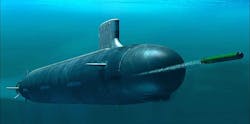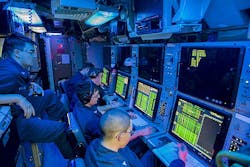DARPA eyes bistatic sonar with UUV-based pingers to preserve stealth of attack submarines
Officials of the U.S. Defense Advanced Research Projects Agency (DARPA) in Arlington, Va., released a solicitation Sunday (DARPA-BAA-16-10) for the Mobile Offboard Command and Control and Approach (MOCCA) program.
MOCCA seeks to enable manned Navy submarines to use active sonar pings from nearby UUVs to detect and track enemy submarines at long ranges without giving away their presence to potentially hostile vessels.
Traditional active sonar bounces sound waves off of submarines, surface warships, and other objects for detection and tracking. The problem with active sonar, however, is it's like shining a flashlight in a darkened room: it can find objects effectively, but gives away its presence and forfeits any pretense of stealth.
Passive sonar, on the other hand, simply listens for sounds from enemy submarines or surface ships. It's not as effective or as efficient as active sonar, but it preserves stealth and can keep the submarine's presence secret from the enemy.
Bistatic sonar using sonar transmitters aboard a UUV and sonar receivers aboard nearby attack submarines, however, has the potential to gain the best of both worlds.
As long as attack submarine crews have precise knowledge of the position of the pinging UUV, then they can detect the presence of enemy submarines based on sonar sound returns, and track its movements with accuracy. Moreover, attack submarines can keep their locations secret.
The DARPA MOCCA program seeks active sonar solutions that will mitigate the limits of passive submarine sonar sensors, researchers say. The objective is to achieve significant standoff detection and tracking range by using an active sonar projector deployed offboard a submarine and onboard a UUV.
The submarine will need the ability to coordinate the operational functions of the supporting UUV. Thus, the program also must demonstrate reliable clandestine communications between the host submarine and supporting UUV without sacrificing submarine stealth.
The program is looking for companies to develop compact active sonar sources, signal processing, and secure undersea communications technology for an offboard UUV in direct support of submarine ASW operations.
DARPA researchers expect to spend as much as $12 million on the first phase of the MOCCA program, and award several different contracts. Ultimately the program could have three phases over more than four years, depending on how successful the first phase is.
The MOCCA program has two key technical challenges: an active sonar pinger small enough for UUVs, as well as signal processing; and a secure communications link to enable the host submarine to control the UUV at significant distances.
DARPA researchers want an active sonar with an active sonar projector small enough for UUV operations; and bistatic active sonar processing. This will involve developing high-output transducer materials, and a sonar projector that is as energy-efficient as possible.
Researchers want the ability to focus the projected acoustic signal in a direction of interest. The goal is to produce practical and flexible designs for the projector that can scale for several different UUVs and deployment options.
Related: New ship takes lead in countermine and anti-submarine warfare
In addition to a small power-efficient sonar projector, or pinger, researchers also are looking for bistatic sonar processing advancements in reverberation and clutter rejection as well as precision localization capability. The host UUV will be no larger than 21 inches in diameter.
The system will be operated in bottom-limited acoustic environments, so projected sound will scatter and produce reverberation and signal loss. Scattered sound inadvertently may illuminate the host submarine and possibly compromise stealth, so researchers want detailed and accurate predictions of the acoustic environment to manage the sonar and potential exposures.
Researchers also need a secure and reliable communications link to provide positive control of a UUV and its sonar payload operating at a significant distance from its host submarine. The communications link also must be able to communicate information generated on the UUV back to the host platform.
An ideal link would have a low probability of intercept and of exploitation and provide high link reliability. The MOCCA communications link cannot degrade submarine stealth.
Companies interested should submit proposals to DARPA online at http://baa.darpa.mil/my.policy no later than 15 March 2016.
Email questions or concerns to DARPA at [email protected]. More information is online at https://www.fbo.gov/spg/ODA/DARPA/CMO/DARPA-BAA-16-10/listing.html.

